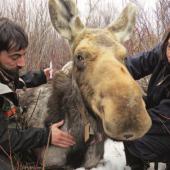Fisher King
Two hundred and one years ago this month, Merriweather Lewis sat down at a table in rainy Fort Clatsop and gave consideration to an animal the Indians called “pekan,” one he personally referred to as the “black fox.” He described it thus:
“they are extreemly active strong and prepared for climbing, which they do with great agility, and bound from tree to tree in pursuit of the squirrel or Rakoon their natural and most usual food. Their colour is jut [jet] black except for a small spot of white in the breast. The body is long, legs short and formed something like a ter-spit dog, with a remarkable long tail.”
Lewis’s observation was a keen one, and the animal he described with great accuracy was the fisher, a member of the weasel family. And while one could not improve on this picture of the fisher (as long as you are familiar with the “ter-spit dog,” which we would call a terrier today), you may wonder why an animal that eats squirrels and raccoons is called a “fisher.” If so, you are in great company. Lewis himself found the name of fisher misleading, since “it dose not pray on fish or seek it as prey,” and explains his personal moniker of “black fox.”
Today fishers spend most of their time in mature forests with overhead canopy in search of squirrels, chipmunks, rabbits, and anything else they can get their paws on and overpower. At twenty pounds, with sharp claws on all four legs and a long tail for balancing, they are excellent tree-climbers and efficient predators.
Fishers are also one of the few carnivores that regularly prey on the formidable porcupine. As porcupines are voracious bark-munchers, fishers help maintain help the health of forests by keeping porcupine numbers in check.
But despite their fearsome abilities in the trees, they are extremely shy of people and avoid open areas. They require wet forests with downed trees and logs in which to den and raise young, and in winter will seek cover in brush piles and snow dens.
Because of their habitat requirement for downed lumber and older forests, their U.S. numbers have been reduced, in part, by timbering activities. In many cases the very same downed trees that serve as ideal cover for fishers are selected for removal by lumber operations. Additionally, fishers were trapped-out for their fur in many places throughout the U.S. Today, Montana is the only state in the lower 48 that still allows lethal trapping of fisher.
It is believed there are currently about 600 fishers left in the entire western United States. And while some states are looking to reintroduce fishers back on the land, a few fishers live relatively close to Bozeman today in the high, remote reaches of Gallatin National Forest and in Yellowstone National Park.
Fishers are indeed an elusive subject, both in name and to observe. But a fisher by any name is still just as nimble, feisty, beautiful, rare, and worthy of people’s consideration for their survival.
For more information about fishers and how you can help keep them a part of our American West, please visit www.predatorconservation.org.
Jon Schwedler works for Predator Conservation Alliance, a Bozeman-based wildlife conservation group that works to save a place for predators in the Northern Rockies and Northern Plains.












